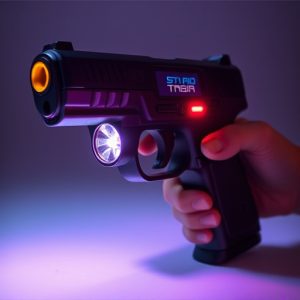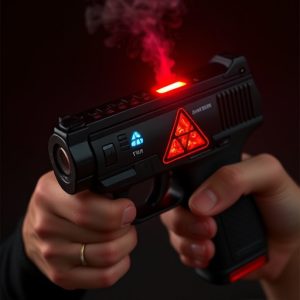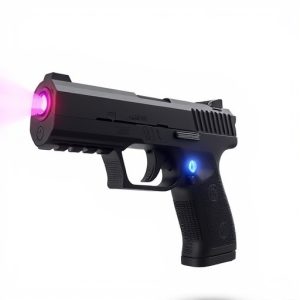Projectile vs Contact Stun Weapons: Unlocking Power, Range & Legalities
Projectile and contact stun weapons, like the Triad Stun Gun, offer non-lethal self-defense options……..
Projectile and contact stun weapons, like the Triad Stun Gun, offer non-lethal self-defense options. Projectiles stun from a distance using electrical and mechanical forces, while contacts devices incapacitate through direct electric shock. The Triad Stun Gun combines these approaches for versatility. Though regulated and with potential legal repercussions, they're popular among law enforcement and civilians for personal safety in various scenarios.
In the realm of personal defense, stun weapons have emerged as game-changers. This article delves into the contrasting worlds of projectile and contact stun devices, examining their unique mechanisms, advantages, and drawbacks. We explore the might of a triad stun gun analysis, considering power and range. Additionally, legal and safety aspects are scrutinized to clarify who can wield these weapons responsibly. Real-world applications highlight why law enforcement increasingly favors stun guns for specific scenarios, making this an essential guide for understanding modern self-defense tools.
- Understanding Projectile Stun Weapons: How They Work and Their Advantages
- Contact Stun Devices: Direct Impact and Effectiveness
- Comparing Power and Range: A Triad Stun Gun Analysis
- Safety and Legal Considerations: Who Can Carry and Use These Weapons?
- Real-World Applications: When and Why Law Enforcement Opt for Stun Guns
Understanding Projectile Stun Weapons: How They Work and Their Advantages
Projectile stun weapons, such as the triad stun gun, operate by projecting a specialized energy charge to incapacitate a target from a distance. Unlike contact-based stun devices that require direct physical contact, these weapons use a combination of electrical and mechanical forces to temporarily disrupt muscular control. When activated, the triad stun gun releases a powerful pulse that travels through the air, striking the target and causing immediate muscle spasms, disorientation, and temporary paralysis. This non-lethal approach makes them ideal for self-defense scenarios where neutralizing a threat is necessary without inflicting permanent harm.
The advantages of projectile stun weapons are numerous. They offer a safe alternative to firearms, reducing the risk of accidental discharge or collateral damage. Their long-range capabilities enable users to disable attackers from a distance, providing crucial time to escape or call for backup. Moreover, these devices are often easier to operate than traditional stun guns, making them accessible to a broader range of individuals seeking personal protection. With their rapid deployment and effectiveness, triad stun guns represent a modern solution for those seeking non-violent means of self-defense.
Contact Stun Devices: Direct Impact and Effectiveness
Contact stun devices, such as the triad stun gun, operate by delivering a powerful electrical shock to the target through direct physical contact. This method ensures that the energy is transferred instantly, making it an effective way to incapacitate an individual quickly. The impact of a stun device like the triad stun gun is usually localized, targeting specific areas of the body such as the arms or legs, causing temporary muscle paralysis and disorientation.
Unlike projectiles, which can be more easily dodged, contact stun devices rely on close proximity and physical interaction. This makes them particularly useful in situations where speed and control are paramount. The effectiveness of a triad stun gun lies in its ability to neutralize an aggressor or threat without causing permanent harm, making it a preferred option for law enforcement and self-defense enthusiasts alike.
Comparing Power and Range: A Triad Stun Gun Analysis
When comparing projectile and contact stun weapons, the triad stun gun stands out as a remarkable innovation. In terms of power and range, triad stun guns offer a unique advantage. Unlike traditional stun guns that rely primarily on electrical shock delivered through direct contact, these devices combine electrical, mechanical, and chemical forces to achieve a more comprehensive stun effect.
The electric charge fired from a triad stun gun is potent enough to disable an assailant within a relatively longer range compared to conventional models. Simultaneously, the weapon’s mechanical impact and chemical agents further enhance its stop-power capabilities. This tri-pronged approach makes triad stun guns versatile tools for self-defense, offering users a decisive advantage in various scenarios without requiring direct contact with the aggressor.
Safety and Legal Considerations: Who Can Carry and Use These Weapons?
When considering safety and legal aspects, it’s crucial to understand that both projectile and contact stun weapons have distinct regulations and restrictions. The accessibility of these devices varies greatly depending on your location. For instance, in many regions, a triad stun gun—a type of non-lethal weapon—is legal for personal protection if the local laws permit its use by civilians. However, strict guidelines often dictate who can own and carry such devices; this typically includes requirements for age, background checks, and training certifications.
Unlike some contact weapons, stun guns rarely have severe physical consequences, making them less likely to cause permanent harm or disability. Nevertheless, their effectiveness still depends on proper usage, and users must be aware of potential legal repercussions if used inappropriately. It’s essential to research local laws and understand the responsibilities that come with carrying any form of self-defense weapon.
Real-World Applications: When and Why Law Enforcement Opt for Stun Guns
In real-world scenarios, law enforcement agencies often turn to stun guns as a less lethal alternative to firearms in certain high-risk situations. These devices, like the triad stun gun, are designed to incapacitate an individual temporarily through electric shock, allowing officers to gain control and de-escalate potentially dangerous encounters. The primary applications include crowd control during demonstrations or public disturbances where immediate neutralization is required without causing permanent harm.
Officers may also opt for stun guns in situations involving violent subjects who pose a threat to themselves or others. Unlike contact stun weapons that require direct physical contact, stun guns with a range offer a tactical advantage, enabling officers to subdue suspects from a distance. This technology is particularly valuable in urban settings where dense populations and limited space can make close-quarters confrontations challenging and potentially dangerous for both the officer and the public.
In conclusion, both projectile and contact stun weapons offer unique advantages in various scenarios. Projectile stun weapons provide a non-lethal option with a longer range, while contact stun devices deliver immediate, localized impact. The choice between them often depends on factors such as power, range, safety, and legal restrictions. In the case of the triad stun gun, its versatility and effectiveness make it a popular choice for law enforcement worldwide, offering a balanced solution for crowd control and personal defense in diverse environments.


